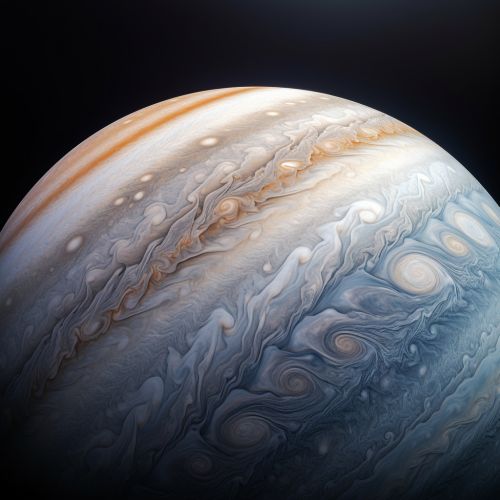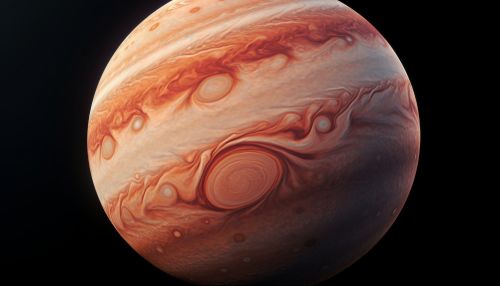Jupiter
Overview
Jupiter is the largest planet in the solar system and the fifth planet from the Sun. It is a gas giant with a mass more than two and a half times that of all the other planets in the solar system combined. Jupiter is primarily composed of hydrogen with a quarter of its mass being helium, though helium only comprises about a tenth of the total number of molecules. It may also have a rocky core of heavier elements, but like the other giant planets, Jupiter lacks a well-defined solid surface. Because of its rapid rotation, the planet's shape is that of an oblate spheroid (it possesses a slight but noticeable bulge around the equator).


Physical Characteristics
Jupiter's upper atmosphere is composed of about 88–92% hydrogen and 8–12% helium by percent volume of gas molecules. A helium atom has about four times as much mass as a hydrogen atom, so the composition changes when described as the proportion of mass contributed by different atoms. Thus, Jupiter's atmosphere is approximately 75% hydrogen and 24% helium by mass, with the remaining one percent of the mass consisting of other elements. The atmosphere contains trace amounts of methane, water vapor, ammonia, and silicon-based compounds as well as trace amounts of benzene and other hydrocarbons. There are also traces of carbon, ethane, hydrogen sulfide, neon, oxygen, phosphine, and sulfur. The outermost layer of the atmosphere contains crystals of frozen ammonia.
Internal Structure
The interior of Jupiter contains denser materials—by mass it is roughly 71% hydrogen, 24% helium, and 5% other elements. Through infrared and ultraviolet measurements, trace amounts of benzene and other hydrocarbons have also been found. The interior contains denser materials, such that the distribution is roughly 71% hydrogen, 24% helium and 5% other elements by mass. It is believed that Jupiter's core is a dense mix of elements – a surrounding layer of liquid metallic hydrogen with some helium, and an outer layer predominantly of molecular hydrogen. The core has also been described as rocky, but this remains unknown as well.
Magnetosphere
Jupiter has a strong and large magnetosphere. In fact, it is the strongest in the solar system. The magnetic field of Jupiter is fourteen times as strong as that of Earth. This magnetosphere is capable of trapping electrically charged particles and creating radiation belts. These radiation belts are hundred times more powerful than Earth's Van Allen radiation belts. Jupiter's magnetic field is also unique as it is generated by the planet's fast rotation and the presence of metallic hydrogen in its interior.
Moons
Jupiter has a significant number of natural satellites. As of 2020, there are 79 known moons of Jupiter, the four largest being Ganymede, Io, Europa, and Callisto. These four are known as the Galilean moons, named after their discoverer, Galileo Galilei. They are among the largest objects in the solar system outside the sun and the eight planets, with radii larger than any of the dwarf planets.
Exploration
Jupiter has been explored on several occasions by robotic spacecraft, most notably during the early Pioneer and Voyager flyby missions and later by the Galileo orbiter. The most recent probe to visit Jupiter was Juno, which entered into orbit around Jupiter in July 2016.
